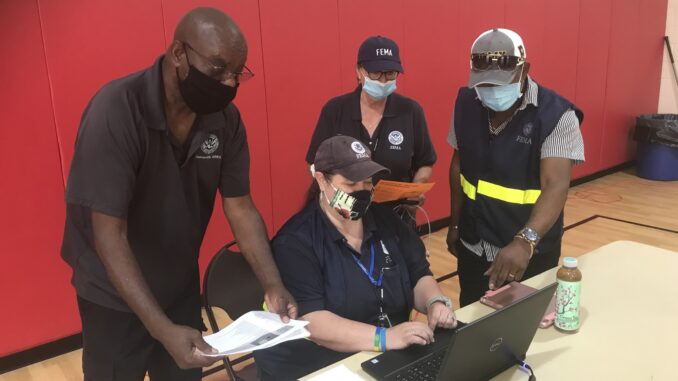
WESTWOOD—Mayor Ray Arroyo has written the members of the New Jersey Senate and Assembly committees that have been tasked with reviewing S790/A4200, which would require reservoirs to implement flood control measures.
He requested of the Assembly committee members, who are hosting a hearing on Oct. 6 to acknowledge the 10th anniversary of Superstorm Sandy and discuss storm mitigation, preparedness and resiliency, that this correspondence be included as testimony for that hearing.
The letter, which he made available to Pascack Press on Oct. 5, was sent to Assembly Environment and Solid Waste Committee and Senate Environment and Energy Committee chairmen and members.
The legislation requires DEP and owners of certain reservoirs to implement certain flood control measures and authorizes Office of Emergency Management to order lowering of reservoir levels in response to severe weather events.
Arroyo urges action that he says is desperately needed to stave off storm-related havoc in costs measured in dollars and quality of life.
State senators Holly Schepisi (R-River Vale) and Joseph Lagana (D-Paramus) introduced the legislation to regulate reservoirs in January. Assemblyman Robert Auth, (R-39) introduced bill A-4200, along with Assemblywoman DeAnne DeFuccio (R-39) and Christopher Tully (D-38).
Westwood’s Frances Yates, a member of New Jersey Flood Solution Advocates and an organizer behind a petition supporting legislation to require flood mitigation from reservoir owners, mostly public and privately owned utilities, told Pascack Press in September, “If they pass this legislation, that will diminish the amount of flooding” from reservoirs statewide.
See “Veolia weathers voices seeking greater flood control,” Pascack Press, Sept. 12, 2022.
Arroyo’s letter is copied to Schepisi, Auth, and Assemblywoman DeAnne DeFuccio, and is well worth reprinting here. He says:
I am writing to share cost projections that underscore the need for S790 and A4200 to be signed into law.
Westwood’s governing body has been considering applying for grants to implement DEP permitted Stream Stabilization. The FEMA nomenclature Stream Restoration describes the same scope of work.\
This program allows removal of some portion of the accumulated muck that has shallowed the creek bed, slowed the channel’s flow, altered its course and reduced its effective drainage capacity. The removed material is reallocated along the badly eroded banks. The banks are reinforced with rip rap (and/or retaining walls where necessary) and the vegetation is replanted.
The Westwood Borough Clerk is the designated point person for researching flood programs. She did a preliminary cost analysis based on estimated unit costs supplied by the borough engineer. A 15% allowance for soft costs was added in. [Arroyo enclosed a supporting spreadsheet, which he said was reviewed and confirmed by the borough engineer.]
Based on these estimates, the cost of removing/reallocating shoals to stabilize, reinforce and restore both sides of the Pascack Brook all along its travel through Westwood would range $5 million to $20 million (plus the 15% added to the final amount), depending upon the mix of applications employed in a final scope of work.
To put the cost scale of the worst-case scenario into perspective: $23,000,000 is more than Westwood’s entire 2022 municipal budget. It is almost 30 times the cost of our 2022 road milling and paving program. And it’s about the cost of the latest round of Westwood Regional School District expansions and improvements to the district’s learning infrastructure.
The physical improvements cited above address purely local conditions. Improving the flow of the Pascack Brook along both sides of its Westwood banks will send more water, more swiftly to the next unimproved stretch in a downstream town. The bottleneck simply follows the path of least resistance.
Still — strictly as a thought experiment — were Westwood, River Vale and Hillsdale to join together and get this done, it would be an impressive drive downfield, setting rushing records and scoring touchdowns. It might win a welcome reprieve of some duration for the residents along the brook in our respective towns.
But it doesn’t win the war against an endless cycle of erosion, silt accumulation, and destabilized stream banks that are ever shallowing the drainage conduits, now carrying more runoff from overdevelopment along the watershed, dropped there by the increasing intensity of rain events. That would require a coordinated, regularly maintained top-of-drainage-basin-to-bottom, federally or state-funded effort that has not been forthcoming.
Whether that failure to launch is due to the aggregate cost of such an effort, the priorities of state and national politics, or simply inertia, the fact remains that the individual municipalities will never be able to fund capital projects to restore channel capacity and flow in any meaningful way.
A full-blown, more universally effective stream stabilization effort along the entire length of the drainage basin would generate costs that are many multiples of the spreadsheet analysis — and even more out of reach.
In the meanwhile, FEMA’s recent Risk Rating 2.0 shifts more of the cost burden of its taxpayer-subsidized flood premiums on to the covered property owners. This is intended to dissuade new construction in flood prone areas. It also analyzes the unique risks to a particular property (actual distance from water and 100% value of replacement cost) versus the general standard of a home’s elevation relative to a designed flood zone.
By FEMA’s own internal estimates this approach could, due to unaffordable premium increases, force one million ratepayers to forego flood insurance by the end of the decade.
Since inception of the new pricing parameters, 165,000 households nationwide have already left the NFIP. These homeowners will risk catastrophic losses, which may generate ancillary, public-safety-net costs.
Such statistical data indicates most cost-effective flood mitigation for our Pascack Valley residents and businesses is the passage of S790 and A4200.
The piecemeal approach the Pascack [Valley] towns might implement via stream stabilization/restoration, while providing highly localized relief, can nevertheless produce other problems downstream even as it multiplies the municipal debt service. Compelling the water utilities to manage their product can significantly mitigate physical damages, alleviate the upward pressure on flood premiums, and reduce the scope of stream stabilization projects to a more cost-effective level.
Recent events underscore yet another reason why the status quo makes no sense. We’ve had a dry summer with no appreciable rain since the Memorial Day week. We’d flirted with flood then, yet the reservoir level, with the gates set to summer mode at 95 feet, had room for the influx due to the drought.
On Sept. 1 the gates, on schedule, automatically went into winter mode at 91 feet, with the reservoir level at 89.5 feet.
Heavy rains that passed through the area over a 24-hour period (Sept. 6–7) came with flood advisory alerts from Bergen County OEM as the rain and runoff quickly filled the newly narrowed headroom, crested the gates and began to overspill.
After hearing all summer about drought conditions, this scenario begs the question of why the gates were not raised to retain more water. Were the dam operators subject to more flexible and situational interventions, more of the water asset might have been retained.
And, had the gates been moved higher than the rote winter mode protocol, the flood alert would have been unnecessary, rendering the inevitable stress on our residents and business owners avoidable.
S790 has not moved in committee since it landed there on Jan. 18 of this year. Neither has A4200. Our local flood association — NJ Flood Solution Advocates — has collected as of this writing over 650 signatures in support of this legislation.
It deserves a hearing and a debate before the next Ida or its ilk wreaks havoc upon our towns.
Westwood Mayor Ray Arroyo

